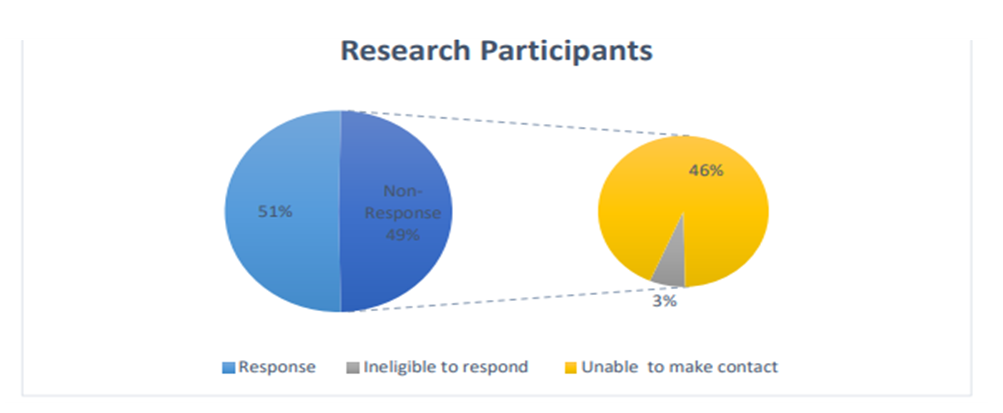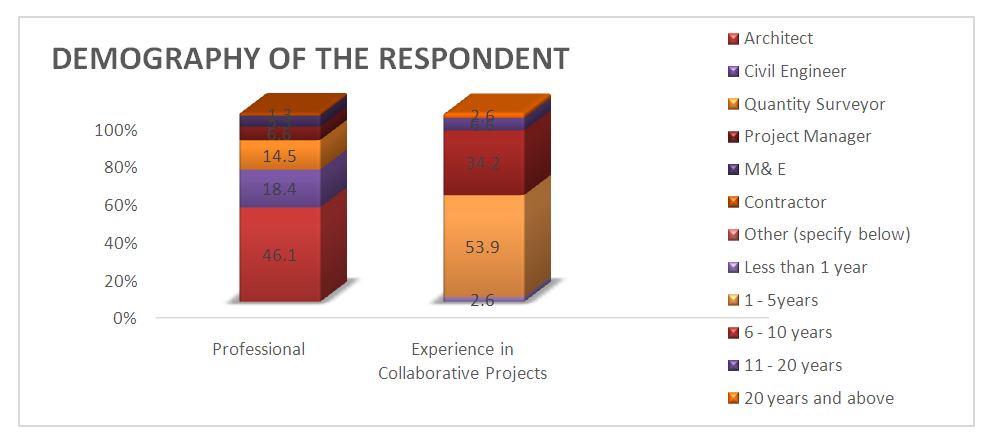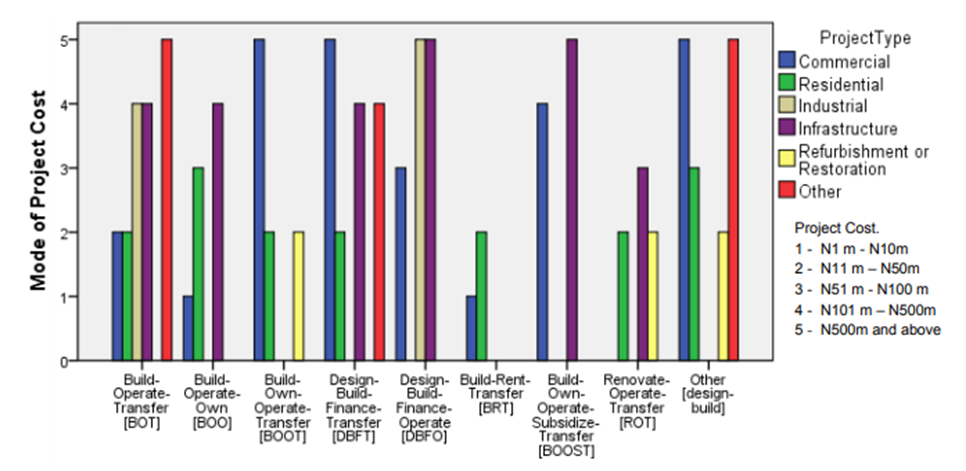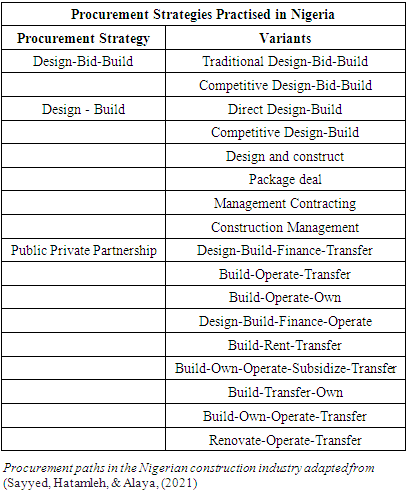-
Paper Information
- Paper Submission
-
Journal Information
- About This Journal
- Editorial Board
- Current Issue
- Archive
- Author Guidelines
- Contact Us
Architecture Research
p-ISSN: 2168-507X e-ISSN: 2168-5088
2022; 12(2): 47-53
doi:10.5923/j.arch.20221202.03
Received: Sep. 22, 2022; Accepted: Oct. 8, 2022; Published: Oct. 21, 2022

Influence of Collaboration on Performance of Procurement Practices in the Nigeria Construction Industry
Chimene Okere, Nwachukwu Chijindu Victor C. V., Esau James Esau
Nigeria
Correspondence to: Chimene Okere, Nigeria.
| Email: |  |
Copyright © 2022 The Author(s). Published by Scientific & Academic Publishing.
This work is licensed under the Creative Commons Attribution International License (CC BY).
http://creativecommons.org/licenses/by/4.0/

Collaboration and collaborative workings have been identified as facilitators of development in the construction sector. The construction industry is one of the most demanding industries, labour intensive and intertwined with diverse procurement practices. It requires team management and collaborative work to enable project delivery and to achieve productivity and performance. Therefore, this study aims to assess the influences of collaboration and its impact on the performance of procurement practices in Nigeria's Construction Industry.The research strategy follows a pragmatic philosophy and a deductive approach; data were gotten using a well-structured questionnaire to understand and measure the performance of collaborative practices on construction projects. Descriptive analysis was used, and the mean item score was used to analyze the challenges of collaborative practices in the construction industry. The findings show that Build-Operate-Transfer [BOT] and Design-Build-Finance-Transfer [DBFT] were selected by the respondents as the procurement strategy that most influenced collaboration. Deficiency of technical know-how was ranked last, whilst Misappropriation and Poor Financing was ranked first among the challenges which hindered collaboration practices. This research will serve as a guide for improving procurement strategy, formulation of policies to enhance collaboration, and addressing the challenges tackling the Nigerian construction industry. Furthermore, this research contributes to the body of literature for future research on collaboration and collaborative workings in Nigeria. It serves as a learning tool as it examines the performance of the Nigerian construction industry which focuses on collaboration and collaborative practices.
Keywords: Collaboration, Construction Industry, Performance, Procurement, Procurement Practices, Nigeria
Cite this paper: Chimene Okere, Nwachukwu Chijindu Victor C. V., Esau James Esau, Influence of Collaboration on Performance of Procurement Practices in the Nigeria Construction Industry, Architecture Research, Vol. 12 No. 2, 2022, pp. 47-53. doi: 10.5923/j.arch.20221202.03.
Article Outline
1. Introduction
- The construction industry is seen as a stimulant for the country's economy in terms of its advancement (Polyakov et al., 2021). It plays a significant role in national development by contributing to the economy's GDP. However, Akinola and Akangbe (2021) posited that this construction industry, by its nature, has many special problems and requirements; and also noted that the Nigerian construction industry is faced with many problems just like the United Kingdom construction industry upon which it is modelled in terms of cost overrun and time management (Akinola and Akangbe, 2021). Series of scholars have highlighted that the construction industry is associated with problems such as poor performance, low productivity, poor quality, high fragmentation, inadequate team works and lack of procurements, among many other management difficulties that affect the performance measure. Performance measure has been generally based on preference. Kamal et al., (2019) stated that the project parameters of performance are the three points of a triangle which are time, quality, and cost while other studies asserted that performance can be measured based on sustainability and safety (Akinola and Akangbe 2021). It is noted that the Nigerian construction industry is plagued with “adversarial” and poor performance which has been a growing concern for all stakeholders. This effect is comprehensible, since the majority of the project management control cost, time, and safety but neglects collaborative practices and their impact. Quality in terms of the procurement system brings about collaboration. Collaboration can be defined as “the act of working with another or others on a joint project, or something created by working jointly with another or others (Blundell et al., 2016), Collaboration and collaborative acts have been identified as facilitators of development in any organization, it encourages teamwork and proper project delivery, that is performance cannot be properly measured without a proper collaboration among the stakeholders. Therefore, this study believes that collaboration is the fundamental criterion for the success of any project and can determine other performance measures. Hence, this paper assesses how the performance of procurement practices influences collaboration in the Nigeria Construction Industry. More so, the objectives of the study are to assess the performance of collaborative practices on construction projects and their challenges in the construction industry.This paper helps academics to identify new ways of improving performance, and setting a major template for procurement, rule, and regulation, also it enables the employee, community, and each stakeholder to understand, and acknowledge collaboration among professionals and in practical terms, this study is to improve understanding of construction delivery in achieving set performance objectives through collaboration.
2. Literature Review
- CollaborationThere are several intertwined definitions of collaboration. Collaboration is defined by Roberts, and Hadjipavlou (2021) as “the act of working with another or others on a joint project, or something created by working jointly with another or others”. This definition is supported by Jamieson, (2022), who argues that true collaboration is an active commitment to shared power, resources, and technical abilities; no individual’s opinion supersedes due to authority residing in the group and work output reflects the contribution of all participants.Types and Levels of CollaborationThere are three identified levels of collaboration in the construction industry as identified by Abioye, Oyedele, Akanbi, Ajayi, Delgado, Bilal, and Ahmed, (2021); wherein the types of collaboration are the classified level. These include;The first level of collaboration comprises of Partnering, Frameworks, and Consortia. Partnerships are team-based working which use an organized management approach to ensure a collaborative relationship with improved stakeholder participation. It entails openness, shared mutual objectives, the involvement of the supply chain and better risk allocation, and problem and conflict resolution. The second level of collaboration is given as Strategic Partnering and Alliancing. Abioye, et; al, (2021) stated that Construction gives collaboration as a combination of partnering and frameworks. It also includes long-term client and single-party relationships in a pain and gain-share scheme, open costs approach towards the creation of sustainable culture and relationship. Strategic partnering / Alliancing seeks to reduce supply chain tendering costs using pre-agreed pricing schedules and long-term performance-driven contracts. While the third level of collaboration includes collaborative client procurement, client and supply chain collaboration, and purchasing consortia. Collaborative client procurement implies clients collaborating to procure services, goods, and materials. The aim is to maximize value for money by securing low purchasing costs.Collaboration in the Nigerian Construction SectorAccording to Kumaraswamy and Mahesh, (2022), the traditional procurement strategies still being employed in the construction industries of developing nations have failed based on the adversarial relationship which still exists as well as the inefficiencies and poor performance of these industries. The study also argues that the Nigerian construction industry is plagued with “adversarial” and poor performance which has been a growing concern for all stakeholders; citing the traditional procurement system prevalently practised in Nigeria as a major factor that influences the decline in efficiency because it fosters an adversarial culture. Findings from previous studies of related literature (Pickavance, 2022; Egan, 1998; Hamidah et al., 2014; Latham, 1994; Oyewobi et al., 2011; Abioye, 2021; Wu et al., 2008), recommend partnering and collaboration as a means to boost the efficiency of the construction industry and also propose Government’s public procurement policies geared towards collaboration. Kumaraswamy, & Mahesh, (2022) assert that Nigeria unknowingly limits partnering and collaboration by its construction laws which border on “due process” which implies competitive bidding and tendering and focuses on the Design-Bid-Build procurement strategy. Corroborated by the author, who reviewed the Nigerian Public Procurement Act 2007, there were no provisions for partnering and it was fixated on competitive bidding and procurement of the lowest bidders with the capacity to execute the specified project. Competitive bidding enshrined in Nigerian public procurement has encouraged an adversarial culture and eradicated goodwill among stakeholders in the industry. Although, one would argue its benefits of attaining the best value for the lowest market price, in a bid to make the public procurement process transparent. The beneficial impacts have not outweighed its demerits of budget and cost overrun where research by Idoro, (2012) asserts that the traditional Design-Bid-Build overrun their initial costs by 53.3%. Seemingly, the author’s opinion of a critical review of public procurement is long overdue, however, as with policies in the country, it would be easier for the biblical camel to dance through the eye of the needle, than for the “corrupt class” of political members of parliament (MPs) devoid of public accountability to review a policy that would not line their pockets with largesse. Furthermore, with the country saddled with corruption fears, Kumaraswamy and Mahesh, (2022) argue that the cost of partnering would mitigate its propagation as an efficient alternative to the traditional method of procurement in public projects. Other factors which have been identified as barriers to collaboration in the Nigerian construction industry include lack of commitment by stakeholders, lack of trust, especially from new entrants with experience steeped in an adversarial culture, and unfamiliarity with the partnering procurement strategy. One key feature which was identified from research by Kumaraswamy, & Mahesh, (2022) was unstable leadership especially as public projects could see two or three regimes before delivery, and more often than not, they end up as abandoned projects if they do not align to the goals of a new regime. Projects are usually one-off and would not encourage partnership builds over time (Kumaraswamy and Mahesh 2022). All is not bleak as the author argues based on his experience in practice, that major architectural firms of the Nigerian industry have implemented BIM up to level 2. However, other participants predominantly utilize BIM for 3D visualizations and have not embraced the collaborative benefits of BIM. Abubakar, Ibrahim, Van, Quoc & Le Dinh, (2021) give factors that have affected the adoption of BIM in the Nigerian construction industry; they cited a lack of government support through legislation although, their research findings highlight the lack of trained or skilled professional and the unaffordability of the BIM tools ranked highest as barriers for adoption and implementation of BIM. Other drivers highlighted by Khanna et al., (2021) include clients’ interest in utilizing BIM for projects, awareness amongst stakeholders, cultural change from a traditional system of design and construction, lack of perceived benefits of financial gains, and the irregular state of power. Its recommendation call for the development of a BIM framework as exists in advanced economies like America, the UK, and Australia and integration into the curriculum of tertiary institutions.Procurement Practices in the Nigerian Construction
|
3. Research Methodology
- This paper is to assess the influence of collaboration on the performance of procurement practices in the Nigeria Construction Industry. The paper adopted a strategy pragmatic philosophical stance through a deductive approach, questionnaire surveys were also used. Moreso, an extensive literature review was carried out to measure the impact of collaboration and collaborative working in the Nigerian construction industry, and to understand the challenges of collaborative working to stakeholders and the Nigerian construction industry. This approach has been successfully implemented by researchers which include Black, Akintoye, and Fitzgerald, (2000), Wasiu and Amirudin (2016); and Wu, (2009) which justify the suitability of the strategy to best fulfil the research objectives. This research adopts a deductive approach as it tries to identify and rank the challenges of collaborative workings in the Nigerian industry thereby studying theory about the impact of collaboration and collaborative workings, getting views from stakeholders in the industry in a bid to understand if the perceived benefits of collaborative workings are achieved in the Nigerian construction industry. The research suggests approaches in selecting an appropriate data collection method which includes Direct Observation – to inquire about acts done in public, Questionnaires - to inquire about their private acts, Questionnaires or Attitude Scales - to inquire about their thoughts, feelings, and belief and the use of Standardized analysis – to measure and understand their abilities, personalities, and intelligence. Other data collection methods posited by Robson, (2011) include indirect or unobtrusive data collection methods which literature, archival and content analysis. The survey e-questionnaire was administered through emails to 150 participants. Data expected from the questionnaire using descriptive statistics.
4. Data Presentation and Discussion
- Figure 1 shows, that there was a 51% response (76 participants) and 49% non-response (74 unreachable participants) of which 5 participants were ineligible as they did not reach the research requirement and had no experience in collaborative projects.
 | Figure 1. Research Participants |
 | Figure 2. Demography of the Respondent |
 | Figure 3. Project Procurement Method |
 | Figure 4. Identifies the challenges of collaborative practices in the construction industry |
5. Findings and Discussion
- The response rate of 52% aligns with (Ekung et al., 2014; Rahman et al., 2014; Saunders et al., 2012). A rate not lower than the 30 - 40% range is acceptable and cannot be referred to as biased. The findings show the distribution of collaborative project types within the Nigerian construction industry. The study aims to identify the challenges of collaborative practices in the construction industry. These findings were conducted in the bid to check for a direct relationship between Project Type, Project cost, and Procurement method to ascertain Design Build Finance and Operate as an appropriate procurement that influences collaboration. Also, the study identified the challenges to collaborative workings as Deficiency of Technical Know-how, Poor Inter-relationship and Communication between Stakeholders.
6. Conclusions and Recommendations
- Collaboration and collaborative works have contributed immensely to the development of construction industries where they are practised. The Nigerian construction industry has embraced collaboration though it needs drastic improvements and legislative support to benefit from collaborative works as there are still severe adversarial issues surrounding the industry.The objectives of this study show clear guidelines for understanding how collaboration and collaborative works have impacted the Nigerian construction industry. These objectives were successfully achieved through an extensive literature review and the study was analysed from an in-depth survey of professionals in the industry.In fulfilment, the study, therefore, recommends improving collaborative working practices in the Nigerian construction industry, also Nigeria’s construction industry is on the right path in development, however, all professionals need to collaborate to sustain the progress for greater advancements in technology, knowledge transfer and overall growth in performance of the sector.
 Abstract
Abstract Reference
Reference Full-Text PDF
Full-Text PDF Full-text HTML
Full-text HTML